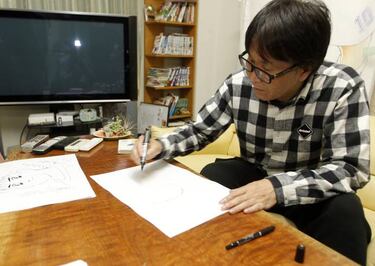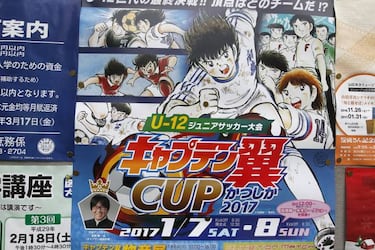“Cristiano and Messi are more fantastical than Ozora Tsubasa”
Yōichi Takahashi doesn’t usually give interviews. Diario AS was delighted when he agreed to speak to us and invited us to his home. <a title="Juventus-Barcelona live online: International Champions Cup 2017" href="https://en.as.com/en/2017/07/22/football/1500709534_932727.html">Juventus-Barcelona live online: ICC 2017</a>

Hungry Heart
Yōichi Takahashi doesn’t usually give interviews. Diario AS was delighted and honoured when the Japanese illustrator and manga artist agreed to speak to us in the comfort of his own home.
What does manga mean to you?
For a long time now it has been my profession, but when I was young, I always dreamt that one day I might become a great illustrator. And just like for many football stars, in the end my dream came true.
Can you tell us why there is such a great tradition of illustration in Japan and where is it placed within the country’s cultural landscape?
Manga culture is very big in Japan. During the Edo period (when the country’s frontiers were closed to the outside world) 300 years ago, there were many important works produced within the Ukiyo-e genre. People have always expressed themselves through drawing and painting. In more recent times, following the war, since the emergence of [manga illustrator Osamu] Tezuka, manga has been popular in Japan. It’s one of the bases of our culture. Out on the street you will see drawings on the façades of every building, on every billboard, on every corner. Drawing is an integral part of our lives.
Do you have an interest in the work which comic illustrators outside of Japan produce?
Whenever I go abroad, I try to find out what work foreign artists are doing. There are a few American artists whose work I have liked, but I feel that the manga created here in Japan is still the number one. Because it has more detail, it expresses more thoughts.

How many hours a day do you dedicate to drawing?
When I enter into the creative process, I'm fully immersed for 24 hours - from the moment I get up until I go to bed.
What inspired you to create Capitán Tsubasa (titled: Oliver y Benji in Spain)?
When I was18, I watched the [1978] World Cup finals in Argentina and was totally fascinated by it, I loved the football that was played there. In Japan, it was almost completely unknown. I wanted to make it popular and so I started producing drawings…
Was it a struggle to get the work accepted and published?
It took about two or three years to take the project forward. But then it was my first job.

How do you feel about being the person who was responsible for promoting and developing football in Japan?
When the series first came out in 1981, there wasn't even a professional football league. It's a great honour to have been able to contribute to making the sport as well known as it is today. Now we have a strong league in Japan and the national team usually plays in the World Cup.
What attracted you to football?
The freedom. When I was a boy, I played baseball. But I always felt I was put under pressure by the coach, for the instructions he gave. You couldn't do anything which he had not told you to do. But in football, although there is a coach, when the players are out on the pitch, it's they who decide where the game has to go. The players have to take decisions themselves. That is quite similar to my profession. Football players can be artists, they express who they are out on the pitch. That's my philosophy too. Illustrators and cartoonists search for freedom on paper, and footballers, on the field of play.
Which footballer fascinated you first?
[Mario] Kempes, at those World Cup finals. And later Maradona, who I got to see play in the flesh. It transmitted something special to me, something different. They would always do the complete opposite of what you were expecting them to do. They always surprised you, and they were always right in those decisions. He was the one who inspired me to create the story and he is behind the character, Juan Díaz.
How do you decide on the countries in which adventure moves to?
Right now, for example, it's in Spain. They are about to take part in the Olympic Games in Madrid.Football is an international sport. If a Japanese player wants to become the world's number one, they have to play outside of Japan.

Do you watch a lot of football?
Quite a lot… Both at the stadium and on television.
In your opinion, where is the best football played at the moment?
In LaLiga (laughs).
What dod you think of Spain's successes?
I was always very interested in Spain's style of football because Spaniards, in comparison to most other Europeans, are not very tall or as strong. It's similar with the Japaneses. La Roja beat the stronger teams with their passing game. I love that style of football and I would love it if one day Japan could win the World Cup playing like that.
I have a question for you - how long is the pitch in the series? It seems to go on forever…
(Laughs). It's not the first time I've been asked that question. As an illustrator what interests me is showing the sensations of being a football player. When I express what is going on in his mind, his thoughts, the field becomes longer, the dimensions cease to be that important. I chose that route because I am more interested in the drama, the fiction than makign it resemble reality. If people watch a game on television, they can imagine what might be going through a player's mind, but not what feel. I try to capture those feelings - that is what I try to get across.

Who would Oliver Atom be in real life today?
-Messi.
Are you a Barcelona fan?
Yes, yes…
What are you first memories of watching Barça?
The first live game I ever saw was El Clásico. I was during the time when Figo had just moved to join Real Madrid.
How much of your fictional characters do Messi and Cristiano have?
(Laughs). In CaptianTsubasa there is a rivalry between Ōzora Tsubasa and Kojirō Hyūga - they are the two best forwards. When there is such a big rivalry, it's beneficial for both of them. Messi is like Ōzora Tsubasa and Cristiano, like Kojirō Hyūga.

What do you like about Messi?
He's short, but he never loses the ball, he plays the ball around, gives incredible passes, he scores… He makes the difference. Japanese like those kinds of players - he's only little but he make a difference.
...and what do you like about Cristiano?
His winner's mentality. He's very strong mentally.
I've read that you are also a big fan of Iniesta...
I like him because he is important to Messi. I'd say Ōzora Tsubasa is a mixture of Messi and Iniesta.
Do any Madrid players inspire you?
Right now Sergio Ramos. I like his heroic character which comes to the fore in what he does. He's not just a centre-back. When the team needs him, he's there.

I'd thought you might have said Modric...
Yes, yes, Modric as well… I really enjoyed watching him in the last Clásico.
Have Cristiano or Messi appeared in the series?
Not yet, no.
Will they one day?
I don't think so… To be honest, in both cases what they have done in reality far outweighs anything in fiction.
I've been told you have a football club…
Yes, Nankatsu SC, Ōzora Tsubasa's team is actually the team from the neighbourhood where I was born. When I go abroad I feel a little envious because every town or small city has their own football team. That didn't exist in Japan - that's why I decided to build my own team. My dream is to see them play in the J1 League one day, and for this neighbourhood to have a big stadium where the people can go, next to the Oliver and Benji museum.
Related stories
Is it harder to manage a football team than draw?
(Laughs). Yes, it's a lot harder.
